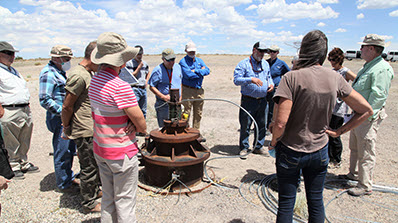Four-day event brought groundwater experts to town
From July 18-21, four peer reviewers joined the EM Nevada Program in Las Vegas to participate in technical briefings, presentations, and a tour of the Pahute Mesa groundwater region at the Nevada National Security Site (NNSS). This nationally recognized group of experts will examine the computer modeling approach developed to estimate forecast groundwater movement and contaminant boundaries in the Pahute Mesa region. To promote stakeholder involvement, members of the Nevada Site Specific Advisory Board also participated, as did representatives from Nye County and the Nevada Division of Environmental Protection.
Under review is thePahute Mesa (PM) Flow and Transport Model Report (FTMR)—a set of conclusions based on complex geologic and mathematical models of groundwater flow and contaminant transport. Over 30 years of intensive drilling, data collection, analysis and modeling went into the making of the model. NNSS scientists use such models to analyze the movement of radioactive contaminants in groundwater.
“We were thrilled to welcome the peer review team to review our newest models and observe our work in the field,” said Ken Rehfeldt, Underground Test Area (UGTA) Project Manager for Navarro Research and Engineering, independent contractor to the DOE. “These models simulate groundwater movement under a wide range of variables and permutations, and they are extremely valuable in ensuring our communities are safe and secure for generations to come.”

Peer reviewers representing the fields of geochemistry, hydrology, hydrogeology and computer modeling that included expertise in using scientific results to make regulatory decisions, gathered for the first two days in the Molasky Center in Las Vegas. They heard presentations and participated in discussions surrounding the Pahute Mesa region, the last open groundwater correction action units at the NNSS. Experts from the EM Nevada Program presented their findings and projections for groundwater movement. The third day saw the group begin their trip to the field, touring Pahute Mesa and a small portion of the Nevada Test and Training Range. On the final day the group traveled to Oasis Valley, observing the principal discharge area for the groundwater basin and notable geological formations, well sites, and monitoring activities in this area.
Current research and modeling forecasts show contaminated groundwater will not reach public water supplies. In 2020, the Rainier Mesa and Yucca Flat groundwater corrective action areas reached closure, successfully bringing 75 percent of all NNSS groundwater regions to end-state completion.
The panel will review the model and generate a final report with their findings and assessment of confidence by the end of September.

